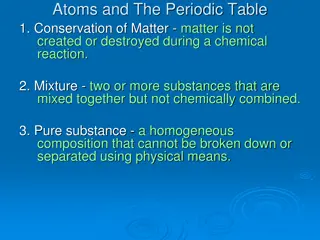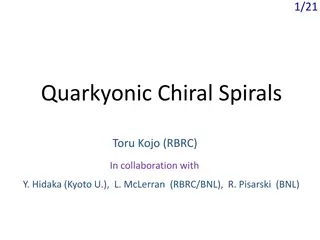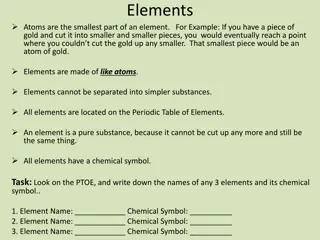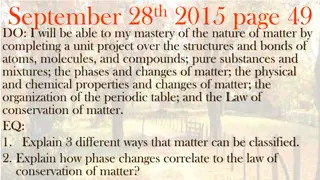Exploring Key Concepts in Chemistry: Nature, Properties, and Structure of Matter
Chemistry encompasses the study of the nature, properties, and structure of matter, as well as the interactions between different substances. It involves understanding the scientific aspects of materials around us, distinguishing between natural and synthetic materials, and considering concepts like purity in chemical terms, contrasting them with common perceptions. The complexity of substances like orange juice exemplifies how even seemingly pure products are chemical mixtures with diverse components.
Uploaded on Sep 08, 2024 | 0 Views
Download Presentation

Please find below an Image/Link to download the presentation.
The content on the website is provided AS IS for your information and personal use only. It may not be sold, licensed, or shared on other websites without obtaining consent from the author. Download presentation by click this link. If you encounter any issues during the download, it is possible that the publisher has removed the file from their server.
E N D
Presentation Transcript
key concepts in chemistry Chemistry is usually defined in terms of being about the nature, properties and structure of matter, or about the properties and interactions of different substances. Chemistry is about the stuff around us and about how we can think about this stuff in scientific terms.
where matter is a general term for stuff, we tend to use the term materials for well defined samples of stuff that we can work with glass, wood, sodium carbonate (washing soda), poly(ethene), diamond, sea water, paint, etc.
A key issue is the notion of natural materials. For a chemist, natural products are those that derive from animal or vegetable sources, but are not considered to make up an intrinsically distinct type of stuff from other materials.
For many people natural materials are considered to be intrinsically better (for example, safer) than synthetic or man-made materials. The assumption seems to be that nature knows best, and man less so.From a scientific perspective, man is part of nature and any material that can be made by man is just as natural as anything secreted, excreted or extracted from a living organism. Indeed there are many berries, fungi, insects and amphibians that produce substances which are harmful or even lethal to people, whereas most synthetic products produced by chemists are subject to extensive safety testing before being allowed onto the market. Many natural products that were once difficult to obtain (for example, those requiring expensive processes to extract and purify tiny quantities of a substance present in living things) can now be synthesised much more effectively, and of course their chemical behaviour is unrelated to their origins.
A closely related idea is that of purity. When buying orange juice to drink, for example, we expect it to be pure in the sense of just being material squeezed from oranges, and not including dead flies, sawdust or the farmer s finger nail cuttings. To assure the potential buyer of this, the manufacturer may well claim to be selling 100% pure orange juice , and in the context of selling and buying a drink this makes perfect sense.
However, we need to know that no matter how pure our orange juice is in terms of only being juice from oranges, it is far from being a pure substance in chemical terms. Orange juice is mostly water, but contains a wide range of other substances including fruit sugar, vitamin C, citric acid, various amino acids and flavonoids that make oranges taste different from lemons or grapefruits. Chemically, orange juice is a mixture of a lot of different substances, even though it is a natural product.
A key distinction is that between materials which can be understood in everyday terms (orange juice is a different material from the glass, paper or ceramic cup we may drink it from) and the constituent substances of these materials
From a chemical perspective, materials are either pure samples of a single substance or a mixture of substances. When a material is a mixture, it can in principle be separated into its components
From a theoretical perspective, we would say that a single substance is one that has a homogeneous chemical composition. The problem is that many mixtures, such as air, sea water, orange juice and bronze, often appear uniform enough. We say they are homogeneous mixtures.
A distinction that is often introduced in school chemistry is between physical and chemical changes. After a chemical change, we have a different substance or substances than before. After a physical change, we have the same substance in a different state or phase.So if ice is warmed it will melt, and if the water obtained is heated, it will boil to give steam: ice water steam H2O(s) H2O(l) H2O(g) Now ice, water and steam have some very different properties and can be considered different materials. However, scientifically they are different states of the same chemical substance: hydrogen oxide (or, rather undemocratically, just water ). These changes ice melting and water boiling are not chemical changes
The term react can imply a response to something, and research suggests that for many students a chemical reaction is understood as one chemical in some sense provoking a reaction in another. That is, one chemical is seen as being the active substance, bringing about change, while the other is more a victim of chemical intimidation! For example, when acids react with other substances, students may assume that it is the acid that is actively bringing about the reaction in the other substance
Consider the following change, which occurs when copper carbonate powder is strongly heated: copper carbonate copper oxide + carbon dioxide This is an example of a decomposition reaction. This is a chemical change, as the substance present at the start (copper carbonate, a green solid) is no longer present after the change. Instead two new substances have been produced: black copper oxide powder and invisible carbon dioxide gas. Copper carbonate is reacting, but it is not reacting to another chemical substance.























